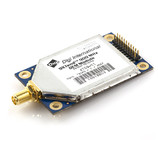Pick a Tracker ($200 - unlimited)
The selection of a tracker is important, as it is what you'll rely on to get your equipment back. The decision depends on a few things, including your level of comfort with basic technical integration to whether or not you have (or know someone who has) an amateur radio license.
The simplest solution based on research is the FindMeSpot satellite
messenger, and though the Edge team has never actually used one, we're aware of a number of teams who have with good success. The problems with this system include the facts that it requires
monthly service fees, doesn't report altitude, stops working above about 60,000 feet (though it does come back to life on descent), only reports once every 10 minutes or so, and requires the chase
team to have an internet connection to track it (smartphones work fine, as long as reception holds... or someone back at the launch site can call to report the final location). The benefit to this
system is that it really is just plug-and-play, with no specialized receiver systems required.
The next simplest solution is our favorite, and is the method that we use for our primary tracking. We use digi's xTend modules (one on the balloon and one on a chase team) for tracking.
These radios are relatively expensive (about $185 from SparkFun), and will require some integration with a power system and GPS,
but, when they're configured correctly, they're bulletproof - we've seen links out to 150 miles. An additional benefit is that they can be used for live mission data in addition to GPS, and more
receivers can be set up (one on chase, one at the ground station, etc), without any trouble at all. Note that the antenna connection is RP-SMA (not terribly common), and the pins are not
breadboard-friendly, though sparkfun does sell a breakout board. The all up cost for a tracking solution built around these radios (not including a laptop with a mapping SW package) is probably
about $750.
Finally, you can use an amateur radio mode known as APRS. This can require some technical prowess as well, and the startup costs are at least as much as the 900 MHz systems for transmission and (reliable) reception. Additionally, amateur radio requires a license for legal operation. The benefits include a built-in network of receiving stations that will put your tracking data online for free, and a low-power, long-range tracking link. Drawbacks include the fact that APRS is not particularly extendable to real-time data, and you don't get very frequent updates (about 1 every minute is all you should set your tracker for). On the inexpensive end, you could get going with this tech for about $500, but to "do it right," you'll be looking at more like $900-$1000. For transmitters, check out Byonics' MicroTrak (what the Edge team flies as a backup tracker) and the BigRedBee BLGPS-2MHP (also very popular with high-altitude teams). Receivers can be purchased from an amateur radio supplier; we use Kenwood equipment (TM-D710 and TH-D72), but it's not inexpensive.
Still have questions? Let us help!



